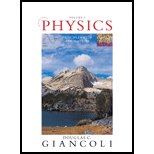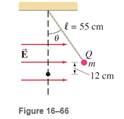
Physics
7th Edition
ISBN: 9780321625915
Author: Douglas C. Giancoli
Publisher: PEARSON
expand_more
expand_more
format_list_bulleted
Concept explainers
Textbook Question
Chapter 16, Problem 57GP
A point charge (m = 1.0 gram) at the end of an insulating cord of length 55 cm is observed to be in equilibrium in a uniform horizontal electric field of 9500 N/C, when the pendulum's position is as shown in Fig. 16—66 with the charge 12 cm above the lowest (vertical) position. If the field points to the right in Fig. 16—66 determine the magnitude and sign of the point charge.

Expert Solution & Answer
Want to see the full answer?
Check out a sample textbook solution
Students have asked these similar questions
Part a-D pl
The figure (Figure 1) shows representations of six
thermodynamic states of the same ideal gas sample.
Figure
1 of 1
Part A
■Review | Constants
Rank the states on the basis of the pressure of the gas sample at each state.
Rank pressure from highest to lowest. To rank items as equivalent, overlap them.
▸ View Available Hint(s)
highest
0
☐ ☐ ☐ ☐ ☐ ☐
Reset
Help
B
F
A
D
E
The correct ranking cannot be determined.
Submit
Previous Answers
× Incorrect; Try Again; 4 attempts remaining
Provide Feedback
lowest
Next >
Part A
m
2πkT
) 3/2
Calculate the integral (v) = f vƒ (v)dv. The function f(v) describing the actual distribution of molecular speeds is called the Maxwell-Boltzmann distribution,
=
ƒ(v) = 4π (· v²e-mv²/2kT
. (Hint: Make the change of variable v² =x and use the tabulated integral foxne
integer and a is a positive constant.)
Express your answer in terms of the variables T, m, and appropriate constants.
-ax dx
n!
-
an+1
where n is a positive
(v)
=
ΕΠΙ ΑΣΦ
Submit Previous Answers Request Answer
?
× Incorrect; Try Again; 4 attempts remaining
Al Study Tools
Looking for some guidance? Let's work through a few related
practice questions before you go back to the real thing.
This won't impact your score, so stop at anytime and ask for
clarification whenever you need it.
Ready to give it a try?
Start
Chapter 16 Solutions
Physics
Ch. 16 - Prob. 1OQCh. 16 - If you charge a pocket comb by rubbing it with a...Ch. 16 - Why does a shirt or blouse taken from a clothes...Ch. 16 - Explain why fog or rain droplets tend to form...Ch. 16 - Why does a plastic ruler that has been rubbed with...Ch. 16 - A positively charged rod is brought close to a...Ch. 16 - Prob. 6QCh. 16 - Figures 16-7 and 16-8 show how a charged rod...Ch. 16 - Prob. 8QCh. 16 - Prob. 9Q
Ch. 16 - Prob. 10QCh. 16 - Prob. 11QCh. 16 - Prob. 12QCh. 16 - Prob. 13QCh. 16 - Prob. 14QCh. 16 - Prob. 15QCh. 16 - Assume that the two opposite charges in Fig....Ch. 16 - Consider the electric field at the three points...Ch. 16 - Why can electric field lines never cross?Ch. 16 - Show, using the three rules for field lines given...Ch. 16 - Given two point charges, Q and 2Q, a distance l...Ch. 16 - Consider a small positive test charge located on...Ch. 16 - A point charge is surrounded by a spherical...Ch. 16 - Q1=0.10c is located at the origin. Q2=+0.10c is...Ch. 16 - Swap the positions of Q1 and Q2 of MisConceptual...Ch. 16 - Fred the lightning bug has a mass m and a charge...Ch. 16 - Figure 16—50 shows electric field lines due to a...Ch. 16 - A negative point charge is in an electric field...Ch. 16 - As an object acquires a positive charge, its mass...Ch. 16 - Refer to Fig. 16—32d. If the two charged plates...Ch. 16 - We wish to determine the electric field at a point...Ch. 16 - We are usually not aware of the electric force...Ch. 16 - To be safe during a lightning storm, it is best to...Ch. 16 - Which are the worst places in MisConceptual...Ch. 16 - Which vector best represents the direction of the...Ch. 16 - A small metal ball hangs from the ceiling by an...Ch. 16 - What is the magnitude of the electric force of...Ch. 16 - How many electrons make up a charge of —48.0 µC?Ch. 16 - What is the magnitude of the force a +25 µc charge...Ch. 16 - Prob. 4PCh. 16 - Prob. 5PCh. 16 - Two charged dust particles exert a force of 42102N...Ch. 16 - Two small charged spheres are 6.52 cm apart. They...Ch. 16 - A person scuffing her feet on a wool rug on a dry...Ch. 16 - What is the total charge of all the electrons in a...Ch. 16 - Prob. 10PCh. 16 - Particles of charge +65, +48, and -95 µC are...Ch. 16 - Three positive particles of equal charge, +17.0...Ch. 16 - A charge Q is transferred from an initially...Ch. 16 - Prob. 14PCh. 16 - Prob. 15PCh. 16 - Prob. 16PCh. 16 - Two small nonconducting spheres have a total...Ch. 16 - Two charges, -Q and -3Q are a distance l apart....Ch. 16 - Determine the magnitude and direction of the...Ch. 16 - A proton is released in a uniform electric field,...Ch. 16 - Determine the magnitude and direction of the...Ch. 16 - A downward electric force of 6.4 N is exerted on a...Ch. 16 - Determine the magnitude of the acceleration...Ch. 16 - Determine the magnitude and direction of the...Ch. 16 - Draw, approximately, the electric field lines...Ch. 16 - What is the electric field strength at a point in...Ch. 16 - An electron is released from rest in a uniform...Ch. 16 - The electric field midway between two equal but...Ch. 16 - Calculate the electric field at one corner of a...Ch. 16 - Calculate the electric field at the center of a...Ch. 16 - Prob. 31PCh. 16 - Prob. 32PCh. 16 - Determine the electric field E at the origin 0 in...Ch. 16 - Prob. 34PCh. 16 - Prob. 35PCh. 16 - Prob. 36PCh. 16 - Prob. 37PCh. 16 - The total electric flux from a cubical box of side...Ch. 16 - Prob. 39PCh. 16 - 40. (II) A cube of side 8.50 cm is placed in a...Ch. 16 - Prob. 41PCh. 16 - Prob. 42PCh. 16 - A point charge Q rests at the center of an...Ch. 16 - Prob. 44GPCh. 16 - Given that the human body is mostly made of water,...Ch. 16 - Prob. 46GPCh. 16 - Prob. 47GPCh. 16 - (a) The electric field near the Earth's surface...Ch. 16 - A water droplet of radius 0.018 mm remains...Ch. 16 - Prob. 50GPCh. 16 - Prob. 51GPCh. 16 - Two small charged spheres hang from cords of equal...Ch. 16 - Prob. 53GPCh. 16 - Dry air will break down and generate a spark if...Ch. 16 - Prob. 55GPCh. 16 - Prob. 56GPCh. 16 - A point charge (m = 1.0 gram) at the end of an...Ch. 16 - Prob. 58GPCh. 16 - Prob. 59GPCh. 16 - Prob. 60GPCh. 16 - Prob. 61GPCh. 16 - An electron with speed v0= 5.32 x 106 m/s is...Ch. 16 - Prob. 63GPCh. 16 - Prob. 64GPCh. 16 - Prob. 65GPCh. 16 - Determine the direction and magnitude of the...Ch. 16 - A mole of carbon contains 7.22 × 1024 electrons....
Knowledge Booster
Learn more about
Need a deep-dive on the concept behind this application? Look no further. Learn more about this topic, physics and related others by exploring similar questions and additional content below.Similar questions
- Starter the rule of significantarrow_forwardPlease solve this problem and give step by step explanations on each step while breaking it down please. Thank you!!arrow_forwardPlease solve this problem and give step by step explanations on each step while breaking it down please. Thank you!!arrow_forward
- No chatgpt plsarrow_forwardNo chatgpt plsarrow_forwardCar A starts from rest at t = 0 and travels along a straight road with a constant acceleration of 6 ft/s^2 until it reaches a speed of 60ft/s. Afterwards it maintains the speed. Also, when t = 0, car B located 6000 ft down the road is traveling towards A at a constant speed of 80 ft/s. Determine the distance traveled by Car A when they pass each other.Write the solution using pen and draw the graph if needed.arrow_forward
- In the given circuit the charge on the plates of 1 μF capacitor, when 100 V battery is connected to the terminals A and B, will be 2 μF A 1 µF B 3 µFarrow_forwardThe velocity of a particle moves along the x-axis and is given by the equation ds/dt = 40 - 3t^2 m/s. Calculate the acceleration at time t=2 s and t=4 s. Calculate also the total displacement at the given interval. Assume at t=0 s=5m.Write the solution using pen and draw the graph if needed.arrow_forwardThe velocity of a particle moves along the x-axis and is given by the equation ds/dt = 40 - 3t^2 m/s. Calculate the acceleration at time t=2 s and t=4 s. Calculate also the total displacement at the given interval. Assume at t=0 s=5m.Write the solution using pen and draw the graph if needed.arrow_forward
- The velocity of a particle moves along the x-axis and is given by the equation ds/dt = 40 - 3t^2 m/s. Calculate the acceleration at time t=2 s and t=4 s. Calculate also the total displacement at the given interval. Assume at t=0 s=5m.Write the solution using pen and draw the graph if needed. NOT AI PLSarrow_forwardThe velocity of a particle moves along the x-axis and is given by the equation ds/dt = 40 - 3t^2 m/s. Calculate the acceleration at time t=2 s and t=4 s. Calculate also the total displacement at the given interval. Assume at t=0 s=5m.Write the solution using pen and draw the graph if needed.arrow_forwardThe velocity of a particle moves along the x-axis and is given by the equation ds/dt = 40 - 3t^2 m/s. Calculate the acceleration at time t=2 s and t=4 s. Calculate also the total displacement at the given interval. Assume at t=0 s=5m.Write the solution using pen and draw the graph if needed.arrow_forward
arrow_back_ios
SEE MORE QUESTIONS
arrow_forward_ios
Recommended textbooks for you

 Principles of Physics: A Calculus-Based TextPhysicsISBN:9781133104261Author:Raymond A. Serway, John W. JewettPublisher:Cengage Learning
Principles of Physics: A Calculus-Based TextPhysicsISBN:9781133104261Author:Raymond A. Serway, John W. JewettPublisher:Cengage Learning College PhysicsPhysicsISBN:9781938168000Author:Paul Peter Urone, Roger HinrichsPublisher:OpenStax College
College PhysicsPhysicsISBN:9781938168000Author:Paul Peter Urone, Roger HinrichsPublisher:OpenStax College Physics for Scientists and Engineers, Technology ...PhysicsISBN:9781305116399Author:Raymond A. Serway, John W. JewettPublisher:Cengage Learning
Physics for Scientists and Engineers, Technology ...PhysicsISBN:9781305116399Author:Raymond A. Serway, John W. JewettPublisher:Cengage Learning Classical Dynamics of Particles and SystemsPhysicsISBN:9780534408961Author:Stephen T. Thornton, Jerry B. MarionPublisher:Cengage Learning
Classical Dynamics of Particles and SystemsPhysicsISBN:9780534408961Author:Stephen T. Thornton, Jerry B. MarionPublisher:Cengage Learning College PhysicsPhysicsISBN:9781285737027Author:Raymond A. Serway, Chris VuillePublisher:Cengage Learning
College PhysicsPhysicsISBN:9781285737027Author:Raymond A. Serway, Chris VuillePublisher:Cengage Learning


Principles of Physics: A Calculus-Based Text
Physics
ISBN:9781133104261
Author:Raymond A. Serway, John W. Jewett
Publisher:Cengage Learning

College Physics
Physics
ISBN:9781938168000
Author:Paul Peter Urone, Roger Hinrichs
Publisher:OpenStax College

Physics for Scientists and Engineers, Technology ...
Physics
ISBN:9781305116399
Author:Raymond A. Serway, John W. Jewett
Publisher:Cengage Learning

Classical Dynamics of Particles and Systems
Physics
ISBN:9780534408961
Author:Stephen T. Thornton, Jerry B. Marion
Publisher:Cengage Learning

College Physics
Physics
ISBN:9781285737027
Author:Raymond A. Serway, Chris Vuille
Publisher:Cengage Learning
Physics Capacitor & Capacitance part 7 (Parallel Plate capacitor) CBSE class 12; Author: LearnoHub - Class 11, 12;https://www.youtube.com/watch?v=JoW6UstbZ7Y;License: Standard YouTube License, CC-BY